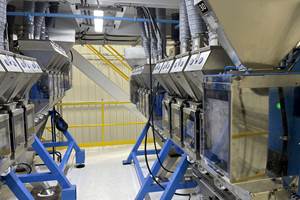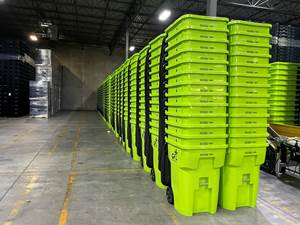UCONN Research Yields Polymer ‘Mechanochromic’ Devices
MATERIALS
New plastics switch from opaque to transparent or change color when subjected to mechanical strain.
Research at the University of Connecticut’s Department of Chemical and Biomechanical Engineering and Department of Mechanical Engineering has yielded polymer-based mechanochromic devices that can become transparent or change color in response to mechanical force.
These were primarily inspired by marine life—specifically animals similar to jellyfish and squids, explains graduate student Sonshang Zeng. “Jellyfish are commonly seen as transparent. Directly in response to touch, their muscles contract, resulting in a wrinkled/folded appearance of their skin.
Because of these wrinkles and folds, light will be scattered instead of traveling directly through the skin, resulting in a more opaque appearance,” he explains. “Squids undergo a similar mechanism, but instead of changing from transparent to opaque, they can make color appear and disappear. When they contract their muscles, they expose pigment sacs that allow color to be shown. Once they release their muscles, the pigment sacs are covered, causing the color to disappear.”
At the labs in Storrs, Conn., Zeng, along with Dr. Luyi Sun of the Dept. of Chemical & Biomolecular Engineering; Dr. Dianyun Zhang of the Dept. of Mechanical Engineering; and Emily Huang, a high-school student, created four mechanochromic devices. The first device is called a “mechanical-responsive transparency-change device.” It’s composed of a two-layer, thin, rigid, transparent film made of a polyvinyl alcohol (PVA)/laponite composite that’s tightly bonded to a soft polydimethylsiloxane (PDMS) elastomer substrate. (Laponite is a film-forming silicate from Byk Additives, Wallingford, Conn.) Once the device is stretched, folds and cracks form in the rigid layer. When it’s released, the surface flattens out and returns to a smooth surface.
Akin to a jellyfish, the wrinkles, folds, and cracks cause a change in the transparency of the device. When the system is released from tension, the surface is smooth, so it’s completely transparent. Once the system is stretched slightly, like 40% strain, folds and cracks form that scatter light and result in an opaque appearance, Zeng explains (see Fig. 1).
The other three devices were inspired mainly by squids’ ability to undergo color change, says Zeng. These systems have structures similar to the transparency-change device: two layers composed of a rigid film atop an elastic material. In the luminescent-device system (Fig. 2), UV-shielding materials are used for the rigid film and fluorescent dye was added to the PDMS. When the device is stretched, cracks form in the rigid layer, allowing the fluorescent dyes behind the cracks to be exposed to UV radiation, producing visible fluorescence. When the device is relaxed, the cracks of rigid UV-shielding film close up, and thus the UV-shielding layer can effectively block UV radiation and the system is not luminescent.
The color-change device (Fig. 3) has a design similar to the luminescent device. However, in this case, green fluorescent dye is added on the top of the rigid UV-shielding layer and orange fluorescent dye is incorporated in the elastomer layer. Under UV radiation, the device emits green fluorescence in relaxed state and shows orange fluorescence when stretched due to the cracks opening and allowing exposure of the orange dye to UV light. This device is extremely sensitive to mechanical stimuli such as stretching, as it can achieve uniform color change at only 20% strain—a value much lower than in similar devices. The sample’s ability to undergo color change is not affected by many cycles of stretching and releasing.
Lastly, by adjusting the elastic layer, a pattern was embedded into the elastomer layer (Fig. 4). This pattern was hidden in the relaxed state and revealed when stretched. All the devices have very good reversibility and the mechanical-responsive optical properties are maintained upon numerous stretching/releasing circles.
Zeng says these devices could be used in a range of applications. “The transparent-change device can be used in smart windows—a small stretching strain allows the device to turn opaque. For the color-changing devices, they can be used in fields such as encryption, strain sensing, or even toys. We are attempting to scale up the technology in order to commercialize the devices.”
See the short videos below to see how each mechanism works.
Related Content
Novel System Produces Color on Demand
Ampacet’s FluxQF technology features a quick-dispersion universal carrier with novel machinery that provides automated color blending in quantities down to 50 lb.
Read MoreSorting Mixed Plastics by Color and Type
Steinert will demonstrate plastic sorting technology at K 2022.
Read MoreSpecialty Purging Compounds Optimize Color and Material Changeovers
Selecting of the correct purging compound can speed up material and color changeover time and reduce scrap. You’ll even save on material.
Read MoreInjection Molder Changes Up Color Changes
An injection molder of trash cans, pallets, totes and other plus-size components, Rehrig Pacific’s machine fleet is composed of larger tonnage presses whose size makes material changes at the feed throat a potentially dizzying exercise.
Read MoreRead Next
Processor Turns to AI to Help Keep Machines Humming
At captive processor McConkey, a new generation of artificial intelligence models, highlighted by ChatGPT, is helping it wade through the shortage of skilled labor and keep its production lines churning out good parts.
Read MoreWhy (and What) You Need to Dry
Other than polyolefins, almost every other polymer exhibits some level of polarity and therefore can absorb a certain amount of moisture from the atmosphere. Here’s a look at some of these materials, and what needs to be done to dry them.
Read MoreTroubleshooting Screw and Barrel Wear in Extrusion
Extruder screws and barrels will wear over time. If you are seeing a reduction in specific rate and higher discharge temperatures, wear is the likely culprit.
Read More


























